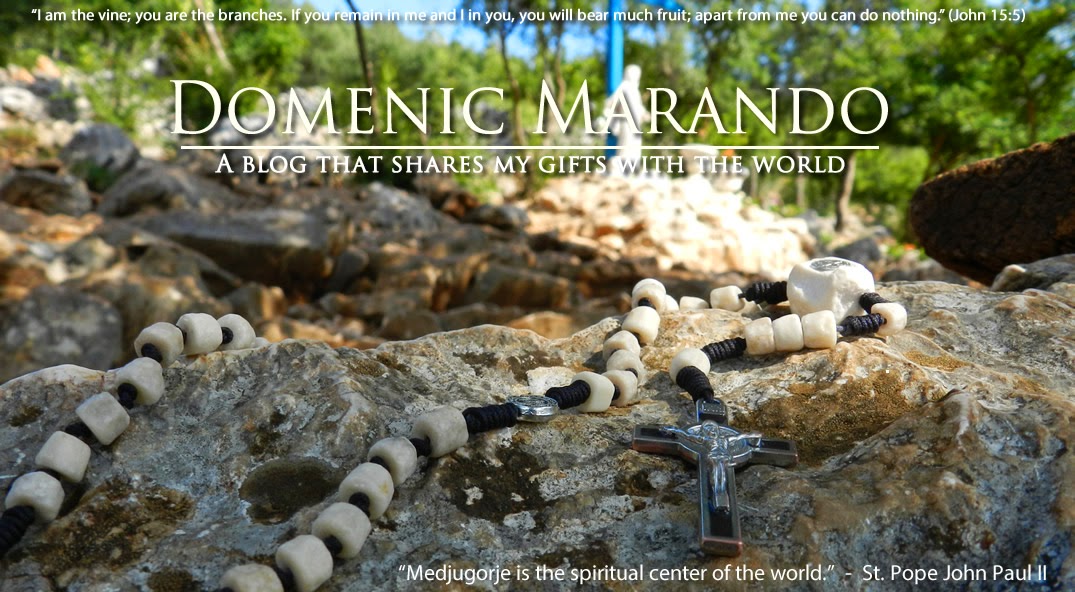 |
| Knights of Christ The King Group ascending up Cross Mountain (Križevac), June 24th, 2014. Father Piotr Natanek is the individual in the middle carrying the cross. |
If you are somewhat surprised by the title of this post and wondering what it might be all about, I am sure you are not alone. This too was my reaction when I first saw an article on Medjugorje Today's web site entitled, Renegade Group Is Loose On The Mountains.
The concern surrounding this Polish Catholic group is with respect to its wrongful acceptance of "private revelations" of a suspended Polish Catholic priest, Father Piotr Natanek, who in his dissension, has spread wrongful opinions regarding the regality of Jesus. As a result Fr. Piotr has gained a Catholic cult following which the above photo depicts.
My initial reaction to this matter had an added meaning not only because of my connection to Medjugorje, but due to the fact that I recognized the Polish group from my first climb up Križevac (Cross Mountain) this past summer. I was intrigued to read more about this matter so I decided to do some research. Today's post shares that information, in which I hope to not only inform those pilgrims that I journeyed with in the Summer'2014, but to also forewarn those individuals that are planning a pilgrimage to Medjugorje.
The suspension of Fr. Piotr was ordered by Cardinal Stanislaw Dziwisz, the former special secretary to Saint Pope John Paul II. It was not a suspension ordered in haste, but was the result of having exhausted all communication efforts to reach Fr. Piotr and have him obey his superiors.
Father Piotr is known for his controversial homilies and messages, which increasingly became a problem for the Catholic Church in Poland because his sermons were being published on the internet. One sermon, in which Fr. Piotr preached against the incursion of Satan in the lives of young Polish people, was published to the internet and within a few days and was seen by more than half a million people.
After having examined the case by a theological commission, Cardinal Dziwisz decided to suspend the rebel priest for his disobedience.
Cardinal Dziwisz explained that Fr. Piotr received more than one admonition and in response should have demonstrated greater self control, and obeyed his superiors. Some of the communication efforts to try to reach Fr. Piotr included disciplinary directives and invitations to meet with his superiors in 2010, and canonical admonishments in 2007 and 2009. Father Piotr's actions were causing damage to the Catholic community around him. In a letter dated July 20, 2011 Cardinal Dziwisz's reveals the seriousness of this matter from the following segment:
...The basis of this decision is produced by the disobedience of p. Peter Natanek and his teachings that are contrary to the teachings of the Church regarding the views of the kingship of Jesus Christ. He is based on the teachings of private revelations and teaching abroad inspired the doctrines of the Church of seven eschatological. Father Peter Natanek distorted in this way not only the established doctrine of the efficacy of salvation in the Church, but also the devotion to the Mother of God, the angels and the saints mixed with magical notions of faith, leading to ridicule the religion of the Church. In his message, distributed by electronic media, undermines the authority of the bishops and priests, accusing them of disbelief and interact with the enemies of the Church. In response to criticism of his fellow pastors and priests try to create its own structures, discouraging his followers to be part of the communion of the universal Church and so exposes them to great spiritual and moral damages...(Annalisacolzi.it)
 |
| More of the Knights Of Christ The King from that June 24th climb up Cross Mountain (Križevac) |
The photos published with today's post are my own that I took during my first climb up Cross Mountain (Križevac). These photos were taken at the base of Križevac, during the few minutes I had to spare after descending down the mountain.
Being in Medjugorje and just completing my first climb up Križevac, I was on a "spiritual high" as you can imagine. I did not expect to encounter a renegade group from Poland. Based on first impressions and what appeared to be a wonderful devotional procession up the the mountain, I was inspired to shoot some photographs. It is only because of today's post have I come to understand the purpose of that inspiration.
My pilgrimage and first climb up Križevac was not negatively affected in any way by this group's presence. In retrospect, I do not speculate as to the sincerity of their devotion to Jesus and the desire to express it in Medjugorje, but what I will state about this group is this; that as a matter of prudence they should severe all ties with Father Piotr, receive the Sacrament of Reconciliation and begin anew in their "sincere" desire to follow Christ. To maintain the course that they are on is spiritually dangerous for themselves and divisive for the Catholic Church.
If you do intend to make a pilgrimage to Medjugorje, I would like to respectfully recommend you remain cognizant of who this renegade group is, should they be present during your pilgrimage. Do not interact or make any contact with them. Carry on with the purpose of your pilgrimage.
May Our Lady Queen of Peace, guide and protect you on your pilgrimage.



